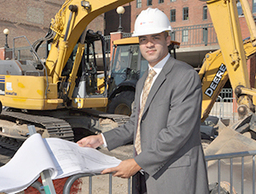Project milestones in 2016 allow hiring plans to move forward
The Southwest LRT project is moving forward this fall with hiring plans after two key milestones: securing all funding commitments for the full local share and completing the environmental review.
Other big milestones include completing 90 percent of the engineering and design, entering into negotiations to procure light rail vehicles for the future METRO Green Line Extension and applying with the Federal Transit Administration to enter the final phase of engineering.
By late spring 2017, the project will complete the design packages for civil construction, systems (electrical power, signaling and communications systems) and the operations and maintenance facility.
In summer 2017, the FTA is expected to issue a Full Funding Grant Agreement, the federal government’s contractual commitment to pay half ($928.8 million) of the project’s $1.858 billion cost.
Southwest LRT career fair Oct. 18 for professional and technical staff
The Southwest LRT Project is ready to hire more professional and technical staff now that local funding is secured and the environmental review process is complete.
We need 71 employees with backgrounds in engineering, construction management, project controls, safety, quality assurance/quality control, finance and administration.
Interested applicants can come to the career fair to talk with current employees in the project office located in St. Louis Park, which today includes 45 staff and 86 consultants.
In addition to the 71 employees needed this fall and early next year, Metro Transit will hire more professional and technical employees for the METRO Blue Line Extension’s construction, set to begin in 2018, and for Southwest LRT operations after passenger service begins in 2021.
“We are looking for individuals interested in a career with Metro Transit. The agency’s plans call for additional transitway projects in the future, which upon completion may be an opportunity for future positions,” said Metro Transit Deputy General Manager Mark Fuhrmann, who is in charge of expanding the region’s light rail system.
Salaries for these jobs range up to $100,000
Starting annual salaries will range up to $100,000 for construction managers. The office senior engineer and office engineer jobs will have starting salaries of up to $77,000 and $71,000, respectively. Safety and quality assurance/quality control inspectors’ salaries will start at $61,000. The senior administrative specialist’s job will pay more than $53,000.
Starting in October through early 2018, check the Met Council website at
http://metrocouncil.org/About-Us/Employment.aspx for postings of the following positions in five waves:
October 2016: Three construction managers and two administrative staff.
December 2016: Up to 23 positions, including three Council authorized representatives to administer construction contracts (one principal engineer or principal contract administrator for each construction contract). Also, 17 assistant Council authorized representatives, who assist in managing the oversight of construction activities and act on behalf of the Council authorized representatives. These positions include: seniors engineers or senior contract administrators focused on specific disciplines such as track, structures, systems, mechanical, civil, electric, etc.; a manager of safety and security; quality assurance/quality control specialists; and a freight rail coordinator.
January 2017: 13 positions to support construction oversight activities, including contract administrators, office engineers, project coordinator and budget manager and budget analyst.
April 2017: Up to 10 construction inspectors, a construction safety and security specialist and a communications specialist.
January 2018: Up to another 10 construction inspectors and one light rail vehicle inspector to inspect the 27 light rail vehicles to be built by a contractor for the project.
Educational requirements
Bachelor’s degrees in engineering, construction management or related fields are required for most positions. The construction safety and security manager and inspector jobs require a bachelor’s in either engineering, safety science, construction management or a related field, while the quality assurance/quality control specialist position requires a bachelor’s degree in construction quality management. The senior administrative specialist’s job requires a high school diploma.
Tips for applying
- Check the Metropolitan Council’s employment page frequently for job postings: http://metrocouncil.org/About-Us/Employment.aspx
- Allow up to three hours to complete the online application with contact information, educational background, professional experience, references and skills.
- Create an account now with professional and educational information to expedite the application process later.
- Use proper capitalization, grammar and spelling to ensure the hiring manager can easily read and understand your information. These positions require the ability to accurately complete detailed reports.
- Fill in blanks and answer questions as completely as possible.
- For instruction and tips, watch: https://www.youtube.com/watch?v=Em4lMdaMDzc
Construction Professionals Career Fair
October 18, 3 p.m. to 6 p.m.
Southwest LRT Project Office
Sixth Floor, Park Place West Building
6465 Wayzata Boulevard, St. Louis Park, MN 55426
Info at: metrocouncil.org/swlrt/construction
Three staff share what they learned building the Green Line
Rick Carey, Angela Myrechuck and Ramoodit “Ram” Kimal did not have backgrounds in rail transit yet all have found a career at Metro Transit expanding the region’s light rail transit system. All three worked on building the METRO Green Line when it was called the Central Corridor LRT Project.
Working on a legacy project, mastering new skills, the professionalism of their colleagues and excellent health benefits are among the reasons they cite for staying. Here are their stories:
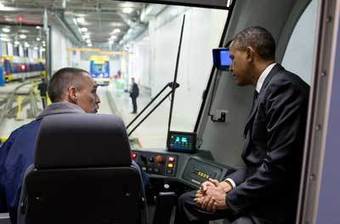 Rick Carey
Left: Rick Carey (left) shows President Obama the controls of a new light rail vehicle during the president's visit to St. Paul in early 2014.
With an associate’s degree in diesel mechanics, Rick Carey of North Branch started cleaning buses for Metro Transit. Carey advanced through the ranks to oversee the procurement of light rail vehicles for the Central Corridor LRT Project (now METRO Green Line), which led to his current job as director of light rail vehicle maintenance for the Green Line. His Central Corridor job involved frequently traveling to California to inspect the assembly of the 59 light rail vehicles built for the project and confer with staff at the Siemens plant. Another career highlight was getting to talk with President Obama during his February 2014 visit to St. Paul to tour the operations and maintenance facility. In a speech afterward at the newly restored Union Depot nearby, the president called Rick’s light rail vehicles “spiffy looking.”
|
Carey reflected on his career path’s humble start.
“I started with Metro Transit in 1980. At that time they hired cleaners and then you were able to bid up to mechanic positions as your seniority allowed regardless of whether you were a trained mechanic or not. I was a mechanic on the bus side for 22 years and then was one of the original 12 mechanics hired for light rail. After years as a mechanic, I was promoted to supervisor in charge of inspecting the three option Bombardier LRT vehicles for the Blue Line. I was promoted to quality assurance/training manager about a year after that and also did the on-site inspections during the locomotive and coach car build for Northstar commuter rail. In 2010, I moved to the Central Corridor LRT Project as senior project manager in charge of the Central Corridor light rail vehicle procurement. In 2013, I moved back to the operation side as the assistant director of rail vehicle maintenance. In 2014, I was promoted to director of rail vehicle maintenance.”
Q. What did you like about working on the Central Corridor LRT Project and what did you learn from it?
A. “I liked the can-do attitude of everyone in the project office. I improved my professionalism being involved in high-level meetings with people outside the organization.”
Q. What advice would you give people considering working on construction of the Southwest LRT Project?
A. “They would gain insight into the workings of the Metropolitan Council (of which Metro Transit is the public transit division). By establishing working relationships with people of the Council, it would improve the chances of a permanent position with the Council for any future positions that open up within their field of expertise.”
Angela Myrechuck
Angela Myrechuck of Minneapolis had 10 years of construction inspection experience in heavy civil and utility construction and a bachelor’s degree from the University of Minnesota in construction management before becoming a construction inspector for the Green Line. Myrechuck quickly advanced to become assistant contract manager for one of the two civil construction contracts. She eventually became contract manager/construction manager for the systems work on the Green Line, overseeing the final design, construction, installation and testing of the LRT power system, rail signaling and communications. She still works for Metro Transit as a principal contract manager in its engineering and facilities group on a variety of public facility projects.
“The knowledge I’ve gained over the past few years on the systems work has made me a more valuable employee at Metro Transit and has opened opportunities for me to expand my career in a direction that I never expected I would have gone,” Myrechuck said.
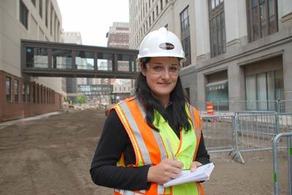 Right: Angela Myrechuck
Q. What did you like about the LRT construction job and what did you learn from it?
A: “Being part of a large public infrastructure project can be stressful due to all of the stakeholders involved and the high-profile schedule but was also very rewarding. I learned many skills relating to engineering and construction management, but above all, further developed my interpersonal and communication skills. Learning how to identify a problem, determine its priority and then work with all of the stakeholders to agree on a solution was the most valuable skill I have learned.”
Q. What advice would you give people considering working on construction of the Southwest LRT Project? What kind of educational background would they need? What kind of previous work experience would be beneficial? What would they gain from working on this project?
A: “Whether you are fresh out of college as an engineer or construction manager, or you are a seasoned professional looking to add a large project to your resume, working for the Southwest LRT project will be a learning experience that will provide a fast-paced environment and unique situations daily. Past experience in construction management is critical for some of the positions that will be hired but there will also be a need for entry-level inspector and engineer roles for motivated individuals. For me, it was extremely rewarding to see a large project come together from utility relocation, to track and station construction and through to revenue service operations. To know I was an integral part of each of those phases is still rewarding every time I see the Green Line trains pass by.”
|
Ramoodit “Ram” Kimal
Ram Kimal of Brooklyn Park made a mid-career change from quality management in the private sector to the government sector to take a job as quality assurance program manager during construction of the Green Line. He holds the same position today on the Southwest LRT Project. His primary responsibilities during design and construction of the Green Line included quality oversight of the design consultants’ and construction contractors’ work for compliance to their contract requirements. He marvels that his career path has taken him a long way from his early years in Guyana in South America where he had no prior involvement in construction, public infrastructure projects or railroading.
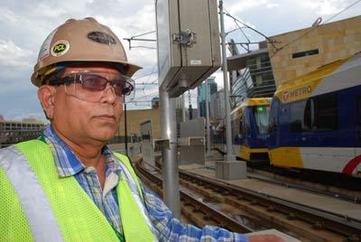 Left: Ramoodit "Ram" Kimal
Q. What does your job entail and how did your educational background (master’s degree in management and administration from Metropolitan State University) help prepare you for your work in LRT construction?
A. “My position involves preparing management reports, chairing meetings, conducting training sessions and preparing plans and procedures. My educational background combined with my work experience provided the necessary foundation in preparing me for this new venture. Additionally, prior to joining Metro Transit, I worked in various non-governmental organizations in the quality arena. My combined formal education and work experiences helped me tremendously in transitioning into LRT construction at Metro Transit.”
Q. What did you like about the LRT construction project and what did you learn from it?
A. “My work at Metro Transit in LRT construction allowed me to apply my knowledge and skills to the fullest. The support from management, peers and colleagues are the main drivers in my continuous growth in LRT construction. Working on a turnkey project and one of the largest infrastructure projects in the state instilled in me a level of confidence and pride in my contribution, knowing that upon completion thousands of residents and visitors to our state will benefit from state-of-the-art mobility.”
Q. What benefits did you most enjoy from your employment at Metro Transit on the LRT construction project?
A. “Affordable health care benefits.”
|
Work to be broken into 5 main contracts
In 2017, the Southwest LRT Project will award three main construction contracts: civil construction, systems, and operations and maintenance facility. The contract to build the light rail vehicles will be awarded in late 2016.
Civil construction
Civil construction involves the building of tracks, roads, bridges, trails, tunnels and park-and-ride facilities. Among other work, crews will build or install:
- 29 miles of track
- 15 stations
- Eight park-and-ride facilities: seven surface parking lots with more than 1,700 spaces and one 450-stall parking structure at SouthWest Station in Eden Prairie
- 110 retaining walls
- Roadways and trails
- Urban design and landscaping
- 29 new bridges for LRT trains, pedestrians, roadways and freight rail
- Modifications to seven existing bridges
- Six pedestrian tunnels
- Two “cut-and-cover” LRT tunnels: 580 feet under Highway 62 on the Eden Prairie-Minnetonka border, and 2,200 feet in the Kenilworth corridor of Minneapolis
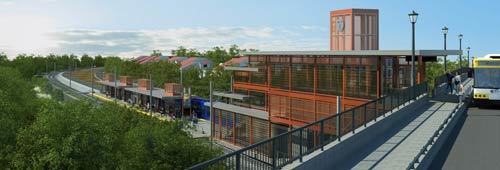  Top: Three of the 15 stations will have stairs and elevators for access to and from roadways above the station platform; those will be at West Lake Street (shown here), Bryn Mawr and Bassett Creek Valley in Minneapolis.
Above: Future bridge for light rail trains over Excelsior Boulevard in Hopkins.
Systems
Systems work will involve building and installing the light rail power, rail signaling and communications equipment.
For the power systems, crews will construct and install 21 small buildings to house electrical equipment that will convert alternating current from Xcel Energy lines into direct current to power the light rail trains. These buildings are called traction power substations and are about the size of intermodal train containers. Nineteen will be installed near the LRT main line and two at the operations and maintenance facility in Hopkins.
Crews will also string overhead wires that will bring the DC power from the substations to the trains and will install LRT and freight signaling systems.
For the two LRT tunnels to be built under Highway 62 and in the Kenilworth Corridor, crews will build tunnel systems houses and will provide ventilation and electrical power for the tunnels.
The communications systems’ equipment that will be visible to the general public include public announcement/variable message signs, security cameras and emergency call boxes and telephones. Installation of intrusion detection equipment in the tunnels, closed circuit TVs and work at Metro Transit’s Rail Control Center are other parts of the systems contract.
Operations and maintenance facility
Crews will remove six existing buildings in Hopkins and construct a two-story, 162,000-square-foot building for the indoor maintenance, cleaning and storage of up to 30 light rail vehicles.
As part of the project, staff will work with the displaced businesses to relocate them.
Crews will also improve the soil on the site, construct track outside the building for moving trains to and from the main line, and build access roads and systemwide electrical cable trough/ductbank/foundations, and install utilities, drainage and landscaping.
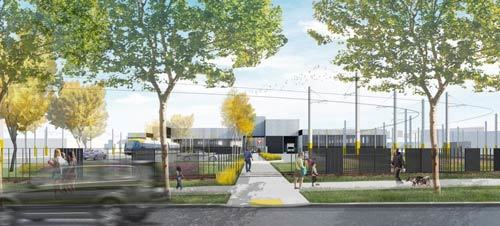 Above: Rendering shows what passersby will see once construction, fencing and landscaping is complete for the operations and maintenance facility for the indoor maintenance, cleaning and storage of up to 30 light rail vehicles.
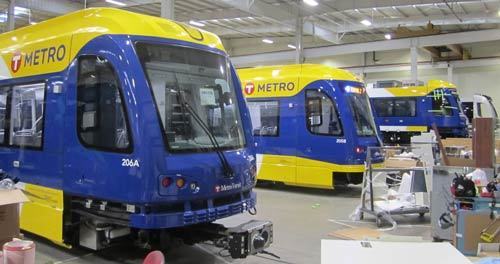 Above: Light rail vehicles on the assembly line for the Green Line.
Light rail vehicles
Evaluation is in progress with a contractor to build the Southwest LRT’s light rail vehicles, and an award is expected in November.
The base order will be for 27 light rail vehicles, with options for up to 50 additional vehicles.
Fare collection
The contractor that receives the award to build the fare collection equipment will be responsible for two main types of equipment.
They are the design and building of 43 ticket vending machines and 66 Smart Card validators.
|
Right: Traction power substation converts AC to DC power for trains.
|
|
 |
|
Right: Flashing signal and sign warn the public to look both directions for approaching trains.
|
|
 |
Project’s local funding is secured, environmental review complete
In August, Southwest LRT Project’s ability to advance to construction received two big boosts.
The project secured local funding to apply for the federal match, and the Metropolitan Council determined the project’s Final Environmental Impact Statement is adequate. That determination concluded the state environmental review process under Minnesota rules. The project then applied with the Federal Transit Administration to enter into the Engineering phase, which is anticipated to occur in November.
For funding details, see:
http://metrocouncil.org/swlrt/news/2016/project-secures-funding
For information about the environmental review, see: http://metrocouncil.org/swlrt/news/2016/feis-adequacy.aspx
Big events lead to record ridership
Metro Transit saw its highest single-day ridership in recent memory when fairgoers mixed with commuters and sports fans across the region.
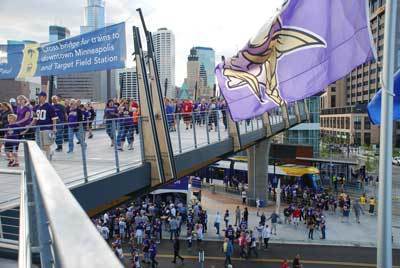 Left: Instead of driving and parking, many football fans took light rail to the new Vikings stadium.
Nearly 370,000 rides were taken systemwide on Thursday, Sept. 1, as the Twins, Vikings, Gophers and Saints each hosted home games and service was provided to the Minnesota State Fair.
With more than 117,000 rides on the Blue and Green lines, a single-day light rail ridership record was also set on Sept. 1. The Blue Line had its busiest day ever, with nearly 59,000 rides. The previous single-day light rail ridership record was set on Sept. 3, 2015, when there were nearly 101,000 rides.
|
About the Project:
The planned Southwest Light Rail Transit (LRT) Project (METRO Green Line Extension) will operate from downtown Minneapolis through the communities of St. Louis Park, Hopkins, Minnetonka, and Eden Prairie, passing in close proximity to the city of Edina. The line will connect major activity centers in the region including downtown Minneapolis, Methodist Hospital in St. Louis Park, downtown Hopkins and the Opus/Golden Triangle employment area in Minnetonka and Eden Prairie. Ridership in 2040 is forecasted at approximately 34,000 average weekday boardings. The project will interline with the METRO Green Line, which will provide a one-seat ride to destinations such as the University of Minnesota, state Capitol and downtown St. Paul. It will be part of an integrated system of transitways, including connections to the METRO Blue Line, the proposed METRO Blue Line Extension, the Northstar Commuter Rail line, a variety of major bus routes along the alignment, and proposed future transitway and rail lines. The Metropolitan Council will be the grantee of federal funds. The regional government agency is charged with building the line in partnership with the Minnesota Department of Transportation. The Southwest Corridor Management Committee, which includes commissioners from Hennepin County and the mayors of Minneapolis, St. Louis Park, Edina, Hopkins, Minnetonka, and Eden Prairie, provides advice and oversight. Funding is provided by the Federal Transit Administration, Counties Transit Improvement Board (CTIB), state of Minnesota and Hennepin County Regional Railroad Authority (HCRRA) and other project partners. The Southwest LRT Project website is www.swlrt.org
| 





